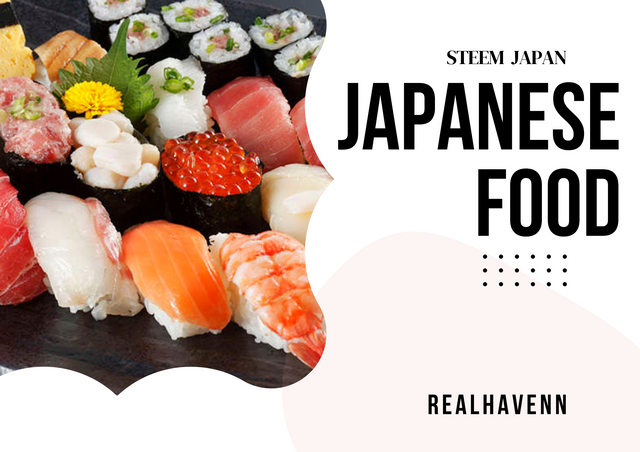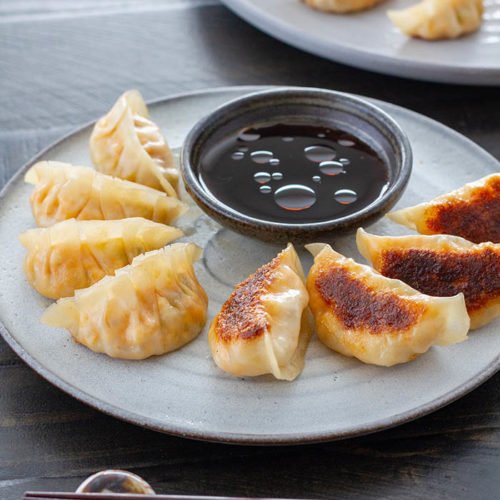JAPANESE FOOD

For good reason, Japanese cuisine is one of the most popular in the world. Traditional Japanese cooking, or washoku, emphasizes variety and balance and is based on "rules of five." Five colors (black, white, red, yellow, and green), five cooking techniques (raw food, grilling, steaming, boiling, and frying), and five flavors are used to achieve this (sweet, spicy, salty, sour, and bitter). Even in a single meal of one soup and three sides served with rice, these principles can be found (ichiju-ju, san-sai). It's no surprise that Japan's cuisine is so delicious and highly valued by people all over the world, given its aesthetic of beautifully presented food and the use of fresh, high-quality seasonal ingredients. Japanese cuisine is well-known around the world, but there is so much more to try in Japan than sushi! Many of us are also familiar with sashimi, tempura, and ramen. However, Japanese cuisine is far more diverse.
Here are some Japanese food you should try out on your next visit to japan.
1. Sushi
Sushi is without a doubt one of Japan's most well-known dishes. Sushi is a dish that dates back to ancient times and is made by preserving fish in fermented rice. It's now made with vinegared rice and fresh fish, and it comes in a variety of styles and shapes.
2. Buta-No-Shogayaki (Ginger Pork)
One of the most popular (and delicious) Japanese dishes. It's available in a variety of restaurants, izakaya (traditional Japanese restaurant/bar), fast food chains, and even as a bento box (a pre-prepared Japanese style lunch) at many grocery and convenience stores.
"Grilled" is the literal translation of the word yaki. Grilling thin slices of pork with a delicate sauce of mirin, soy sauce, sake (Japanese rice wine), granola oil mixed with sliced onions, and ginger results in this dish.
The dish is perfect for any season and makes for a quick and tasty meal.
3. Gyoza
Gyoza are dumplings in the shape of a moon. Another dish that can be found in nearly every Japanese restaurant, regardless of style, but that many people overlook. Despite their Chinese origins, the varieties you'll find in Japan are often quite different from the original.
Gyoza comes in a variety of shapes and sizes in Japan. "Yaki-gyoza" is one of the most popular: the dumplings are filled with minced pork meat, cabbage, garlic, onion, and ginger. Then they're lightly fried until they're crisp and a nice dark gold color.
Serve them with a soy sauce, rice vinegar, and spicy oil dip.
4. Yakitori

Yakitori
Gyoza are dumplings in the shape of a moon. Another dish that can be found in nearly every Japanese restaurant, regardless of style, but that many people overlook. Despite their Chinese origins, the varieties you'll find in Japan are often quite different from the original.
Gyoza comes in a variety of shapes and sizes in Japan. "Yaki-gyoza" is one of the most popular: the dumplings are filled with minced pork meat, cabbage, garlic, onion, and ginger. Then they're lightly fried until they're crisp and a nice dark gold color.
Serve them with a soy sauce, rice vinegar, and spicy oil dip.
5. Karaage

Karaage
As soon as you step foot in Japan, you'll notice karaage, or Japanese fried chicken. Now, karaage usually refers to chicken, but other meats (such as pork) may be substituted depending on where you eat.
Meat is lightly dusted with wheat flour or potato starch before being deep-fried in oil. The ingredients are sometimes marinated ahead of time. It's traditionally served with a slice of lemon on the side, but you can eat it either way.
Restaurants, street-food carts, izakaya, and convenience stores are particularly fond of the chicken variety (and pretty much anywhere else). Karaage is a low-cost, tasty, and quick meal. The only drawback? It's so tasty that it's hard to stop eating it!
6. Kushikatsu

Kushikatsu
This crunchy deep-fried skewered meat, fish, or vegetables dish is also known as kushiage. The etymology refers to the method of preparation, with Kushi referring to the skewers and katsu referring to the deep frying of a meat cutlet.
Bamboo shoots, lotus root, cartilage (nankotsu), and gizzard are used in some of the more interesting varieties (sunagimo). They're all deserving of your attention.
There are several geographical variations, such as Osaka; Tokyo (also serving pork rib kushikatsu), where the meat is prepared slightly differently and dressed with brown sauce; and Nagoya, which is known for its doteni (a rich miso-based dish with beef tendons, offal, and daikon radish). With this staple dish, you can order Kushikatsu.
7.Kaeseki

Kaeseki
Kaiseki is the pinnacle of Japanese fine dining, consisting of a tasting course of small, seasonally themed dishes prepared with meticulous precision and attention to detail. Kaiseki evolved from the traditional tea ceremony, where small morsels of food were served alongside bitter green tea, and these offerings eventually evolved into a multi-course haute cuisine meal.
8.Soba

Soba
Soba is a type of Japanese noodle dish that has been consumed for centuries. Soba, which is made from buckwheat flour, has a long, thin shape and a firm texture, and is very nutritious. Soba noodles, like udon noodles, can be served hot or cold with a dipping sauce, making it a tasty and healthy option at any time of year.
9. Miso Soup

Miso Soup
Miso soup may appear to be a simple dish, but it's an important Japanese dish that goes with any traditional meal. The soup is made with miso bean paste and dashi stock (either fish or kelp stock) to add a savory umami element to any meal. Tofu and sliced green onions, as well as fish, clams, and pork, can be added, and the seasonings may change.
10. Onigiri

Onigiri
Who hasn't seen the famous Japanese rice ball, onigiri, in anime, movies, videos, or documentaries? This is the king of the on-the-go dishes, despite its lack of popularity as a restaurant menu item. It's available in almost every grocery store and convenience store.
Onigiri can be a simple rice ball flavored with spices, or it can be filled (as it usually is) with a variety of ingredients ranging from vegetables to meat, fish, and seafood. Depending on the region and personal preference, it may be wrapped in a sheet of flavored or unflavored nori (seaweed).
Because of its low price (usually around 100 yen), availability, and simplicity, many tourists visiting Japan eat primarily onigiri while sightseeing.
I hope You get to enjoy all these delicious meal on your nest visit to Japan.
Comment Your favorite food that did not show up in my list.
Thank You


Now I know, yosa is the name of what I ate last time.
Downvoting a post can decrease pending rewards and make it less visible. Common reasons:
Submit
Hope you enjoyed it 😊😀
Downvoting a post can decrease pending rewards and make it less visible. Common reasons:
Submit
The description is in point. I have to try one of these one day.
Thanks for the education.
Downvoting a post can decrease pending rewards and make it less visible. Common reasons:
Submit
Yes sir… welcome
Downvoting a post can decrease pending rewards and make it less visible. Common reasons:
Submit
Thank you for sharing posts in japansteemit community.Stay consistent to share unique posts.
Downvoting a post can decrease pending rewards and make it less visible. Common reasons:
Submit
Yes sir. Thanks
Downvoting a post can decrease pending rewards and make it less visible. Common reasons:
Submit